Abstract
Inversion with respect to a unit sphere is a powerful tool when dealing with many problems in Mathematics. This inversion preserves harmonicity in but it does not in for Lord Kelvin overcame this problem by defining a new (at the time) inversion, the so-called Kelvin’s inversion (or transformation). This inversion has many good properties, making it extremely useful in each case where the geometry of the original problem raises issues. But by using Kelvin’s inversion, these issues are transformed into easier ones, due to a simpler geometry. In this review paper, we study Kelvin’s inversion, deploying its basic properties. Moreover, we present some applications, where its use enables scientists to solve difficult problems in scattering, electrostaticity, thermoelasticity, potential theory and bioengineering.
Keywords:
Kelvin’s inversion properties; Laplace’s equation; Stokes’s equation; Stokes flow; potential theory; scattering; electrostaticity; thermoelasticity MSC:
30C20; 35J05; 76D07
1. Introduction
Inversion with respect to a unit sphere is a map where and
It is a conformal map which is used mainly to append ∞ to [1]. This inversion preserves the family of the spheres and hyperplanes in but unfortunately, it does not preserve harmonicity when
In 1845, William Thomson (Lord Kelvin) overcame this issue. In a letter to Liouville, he presented an inversion with respect to a sphere [2]. Practically, he expanded Green’s idea [3], providing a method for solving boundary value problems (BVPs) with partial differential equations (PDEs) [4], which is known as Kelvin’s inversion (or transformation). Its main advantage is that it transforms a harmonic function to a function which, if divided by the Euclidean distance, is also harmonic. Two years later, he published another paper using his inversion in order to calculate the surface charge density of a conductor shaped as a spherical bowl [5]. Lord Kelvin summarized his work in [4].
The advantage of this method is that when the solution of a BVP in the interior of a domain is known, then the solution of an equivalent BVP in the exterior of a domain can be derived and vice versa. This is an important transformation when the inverted problem creates a domain with simpler geometry, something which is not certain. Kelvin’s inversion transforms a biharmonic function to a function which, if multiplied by the Euclidean distance, is also biharmonic [6]. Moreover, it transforms a stream or a bistream function to a function which, if multiplied by the Euclidean distance or the Euclidean distance on the third power, is also a stream or a bistream function [6], respectively.
This method has been used by many researchers in order to solve problems in various scientific fields, such as in acoustic scattering by non-convex bodies, where the method was used to calculate the capacity of a class of convex bodies [7] and in low-frequency acoustic scattering by a hard scatterer [8]. Kelvin’s inversion has been applied to solving the external Dirichlet or Neumann problem in a non-convex body [9,10] using the Fokas method [11,12], problems in electrostaticity [13,14,15] or in thermoelasticity [16], and blood’s plasma flow past a red blood cell [17].
Theoretical results of the Kelvin’s inversion have also been derived. The R-separation and the R-semiseparation of Stokes’ operators in the inverted spheroidal coordinate systems were proved, and the complete set of the corresponding eigenfunctions and generalized eigenfunctions was obtained [18]. The effect of Kelvin’s inversion has been studied in the following operators: the Weinstein operator [19]; the Grushin operator [20]; Laplace’s biharmonic operator; the Stokes stream operator; and Stokes bistream operator [6]. Kelvin’s inversion has also drawn the attention of researchers with regard to the following areas: multi-harmonic polynomials [21]; a-harmonic functions [22]; Grushin equation [23]; and harmonic polynomials on the Heisenberg group [24].
Furthermore, Kelvin’s inversion has applications in numerical analysis. Nabizadeh et al. [25] developed a method using Kelvin’s transformation to numerically solve Poisson, Laplace, and Helmholtz equations. They applied the method in Poisson or Laplace equations using the finite difference method, finite element method, the Monte Carlo method and specifically in the walk of spheres. They compared the results obtained using the walk of spheres with the Russian roulette method, and also the walk of spheres with Kelvin’s inversion, proving the advantage when the domain is infinite. Moreover, they proved two theorems for the method employing the aforementioned equations.
The structure of this manuscript is as follows: in Section 2, we present Kelvin’s inversion, its definition, basic properties, and formulas. In this section, we also prove the lemmas and the theorems that are not presented (as far as we know) in a published paper or book. Moreover, in Section 3, some applications in many scientific fields are shown, while in Section 4, a discussion on the inversion is conducted.
2. Kelvin’s Inversion
2.1. Definition and Properties of Kelvin’s Inversion
Definition 1.
If is a vector in , and is the radius of a sphere, Kelvin’s inversion defines a vector via the relation
where and The center of the sphere is called the center of inversion.
Comment: Kelvin’s inversion is generally defined in [4], but since this transformation does not depend on in this paper, only the cases where and will be studied.
From (2), it is easy to verify that
where The geometric interpretation of (3) is that the inversion leaves all the directions of the position vectors’ invariant.
From the definition of Kelvin’s inversion, it is easy to prove the following lemma.
Lemma 1.
Let be the inverse vector of derived from Kelvin’s inversion, , with respect to a sphere of radius and
- (a)
- Kelvin’s inversion is its own inverse, which means that
- (b)
- If is a constant, it stands that
- (c)
- The unit vectors of are the same, i.e.,
Proof.
Let be the inverse vectors of from Kelvin’s inversion with respect to a sphere of radius respectively.
- (a)
- Then,and therefore,
- (b)
- Moreover,
- (c)
- Finally,
□
Moreover, the transformation satisfies the following proposition.
Proposition 1.
Kelvin’s inversion, K has the following properties:
- It is a radial transformation (i.e., the transformation is based on its distance from a point);
- It is a non-linear transformation since
- It acts on every direction as an one-to-one inversion;
- It maps points near to the center of the sphere to infinity and vice versa;
- It maps a point near and inside the sphere of inversion to a point near the sphere of inversion but outside of it and vice versa (Figure 1).
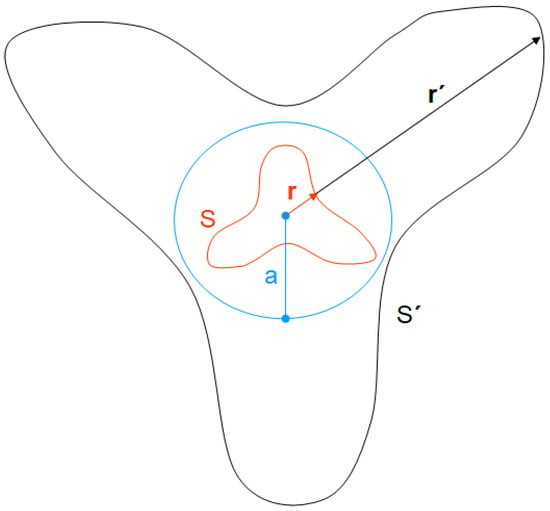
Figure 1.
Kelvin’s inversion in 2D, where S is mapped to S’ with respect to the circle of radius a.
The basic properties of Kelvin’s inversion are stated below.
Theorem 1.
Kelvin’s inversion
- (a)
- Preserves the angle between two vectors;
- (b)
- Inverts spheres to spheres (as we consider a sphere with infinity radius, i.e., a plane);
- (c)
- Inverts planes to spheres passing through the center of inversion and vice versa.
Proof.
Let be the inverted vectors through Kelvin’s inversion with respect to a sphere with radius a of the vectors respectively; so
- (a)
- Let be the angles between the vectors and respectively. Therefore,deriving that since
- (b)
- If is a vector corresponding to a sphere of radius thenreflecting the fact that the inverted vector corresponds to a sphere of radiusThe proof of the reverse proposition is similar.
- (c)
- Let with be the equation of the sphere passing through the point Then, using spherical coordinates [26], we deriveandTherefore,which proves that the image of vector belongs to the plane with equation The proof of the inverse proposition is similar (Figure 2).
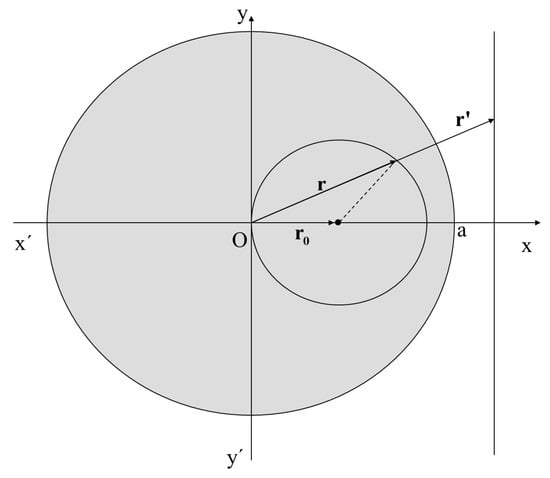 Figure 2. Invert a plane with respect to a sphere.
Figure 2. Invert a plane with respect to a sphere.
□
Lemma 2.
If is the position vector with magnitude is the vector under Kelvin’s inversion with respect to a sphere of radius with magnitude and are the infinitesimal areas on and respectively; and and are the infinitesimal volumes on Ω and respectively, then
Proof.
□
Lemma 3.
If and are the vectors under Kelvin’s inversion with respect to a sphere of radius respectively, with magnitudes, then
Proof.
Since
we derive
□
Some basic formulas employing Kelvin’s inversion [6] are given in the following theorem.
Theorem 2.
If and are the outward normal unit vectors from Ω and respectively; is the unit vector in the direction of is the unit dyadic; and ⊗ is the tensor product, then
Proof.
For the proof, see [6]. □
2.2. Kelvin’s Inversion in Coordinate Systems
Kelvin’s inversion can be applied in a coordinate system, deriving interesting coordinate surfaces. For instance, if we apply the inversion to a prolate spheroid, which is a coordinate surface of the prolate spheroidal coordinate system (Figure 3), we derive an inverted prolate spheroid [26], which is a coordinate surface of the inverted prolate spheroidal coordinate system (Figure 4). In Figure 5, the prolate spheroid, the sphere of inversion, and the corresponding inverted prolate spheroid are presented.
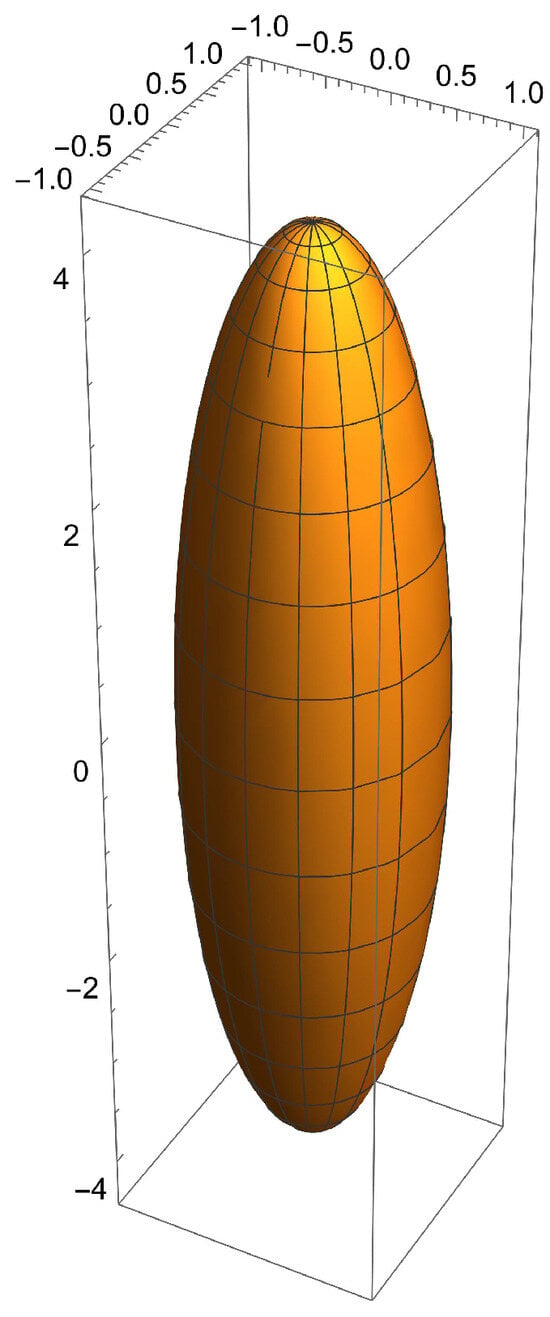
Figure 3.
Prolate spheroid.
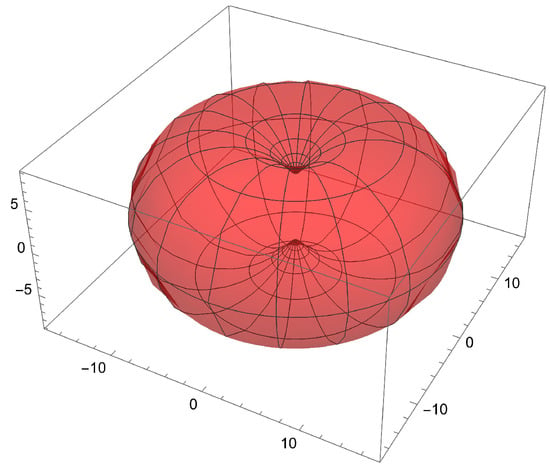
Figure 4.
Inverted prolate spheroid.
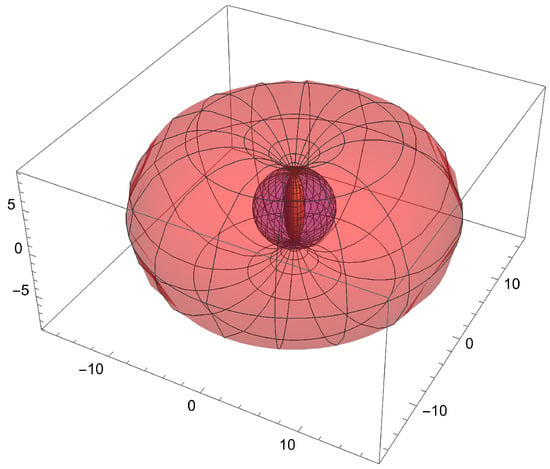
Figure 5.
Prolate spheroid, sphere of inversion and inverted prolate spheroid.
In the case of an axisymmetric coordinate system, the following lemma is valid [27].
Lemma 4.
If is an axisymmetric system of coordinates with metric coefficients and a radial cylindrical coordinate ϖ, and is the corresponding inverted system of coordinates with metric coefficients and a radial cylindrical coordinate , then
where r is the Euclidean distance of the coordinate system
Proof.
For the proof, see [27]. □
2.3. Kelvin’s Inversion in Potential Theory
The effect of Kelvin’s inversion in the Laplace’s operator or the Laplace’s biharmonic operator is given below [6].
Theorem 3.
If is a smooth enough function in Ω, and is the image of Ω through Kelvin’s inversion, then
where ∇ is the gradient in is the gradient in is the inverted vector of with respect to a sphere of radius a, and is the corresponding unit vector of
Proof.
For the proof, see [6]. □
Theorem 4.
If is a smooth enough function in Ω and is the image of Ω through Kelvin’s inversion, then
where Δ is Laplace’s operator in is Laplace’s operator in is the inverted vector of with respect to a sphere of radius a, and
Proof.
For the proof, see [6]. □
Lemma 5.
From the previous theorem, it is easy to conclude that
- If function is a harmonic function in then function is a harmonic function in
- If function is a smooth enough biharmonic function in then function is a biharmonic function in
Proof.
• Since is a harmonic function in then , and from (20), we derive
which means that is a harmonic function in
• Since is a biharmonic function in then , and from (21), we derive
which means that is a biharmonic function in
□
Liouville [28] proved that Kelvin’s inversion is the only transformation in , which preserves angles and harmonicity.
2.4. Kelvin’s Inversion in Stokes Flow
Stokes flow is the flow where the viscous forces dominate over the inertial ones [29,30]. In case of an axisymmetric flow, a fourth-order partial differential equation (PDE) describes the flow through a function called the stream function [31]. If is the axisymmetric system of coordinates with metric coefficients and a radial cylindrical coordinate , and is the stream function, then the PDE which must be satisfied is
where , and the operator is defined as
The effect of Kelvin’s inversion on Stokes’ operator, or on Stokes’ bistream operator, are given below [6].
Theorem 5.
If is a smooth enough function in Ω and is the image of Ω through Kelvin’s inversion, then
where is the Stokes operator in is the Stokes operator in is the inverted vector of with respect to a sphere of radius a, and
Proof.
For the proof, see [6]. □
Lemma 6.
The above theorem implies that
- If is a smooth enough stream function in then is a stream function in
- If is a smooth enough bistream function in then is a bistream function in
3. Applications
In this section, some applications of Kelvin’s inversion will be presented. For more applications, the anxious reader can refer to [32,33,34].
3.1. Scattering
3.1.1. Capacity and Rayleigh Scattering
Dassios and Kleinman [7] calculated the capacity of an inverse prolate or oblate spheroid with the surface The exterior potential problem is
where is the exterior of the inverted spheroid and is Laplace’s operator expressed in the inverted coordinate system.
The capacity of the surface is then calculated by the relation
where is the outward normal unit derivative on
By inverting problem (25) using Kelvin’s transformation, they derived the following interior problem:
and the capacity is now calculated via the relation
where S is the surface of the spheroid, V is the interior of the spheroid, and is Laplace’s operator expressed in the coordinate system.
By applying the inverted spheroidal coordinate system (prolate or oblate), the capacity is obtained, and thus, the low-frequency scattering of a plane wave from an acoustically soft boundary is calculated as the series expansion employing Legendre functions of the first and the second kind [35].
3.1.2. Low-Frequency Acoustic Scattering
Gintides and Kyriaki [8] studied the low-frequency acoustic scattering by a hard inverse-prolate spheroid. The boundary of the scatterer is denoted with and its exterior with The unknown function is expressing the excess pressure field in acoustics; thus, the problem at hand is defined as
where k is the wave number, is the outward normal unit derivative on is a sphere of radius with a center k is the observation vector, and
They expressed the unknown field as a series expansion of and later, every function as a sum of an unknown function, , and a known one,
Therefore, from (29), the functions satisfy the following problem:
In order to overcome the difficulties resulting from (31), they used Kelvin’s inversion, translating an exterior of the inverted prolate scatterer problem in an interior to a prolate spheroid, which was easier to handle, deriving a zeroth and a first-order frequency approximation of their problem using associated Legendre functions of the first kind [35].
3.2. Electrostaticity
3.2.1. Conducting Torus
Cade [15] investigated a conducting torus, which was freely influenced (or charged) by an external field, improving his previous work where the torus was influenced by a field parallel to its rotational axis. In order to obtain the charge density the capacity C, and the total charge Kelvin’s inversion was implemented, transforming the external problem into an internal one.
Cade assumed a torus formed by rotating a circle of radius with a center , around the z-axis, and a sphere of inversion with a center K on the z-axis and a radius R, such that it does not contain or intersect the torus. Therefore, the inverted torus is a torus inside the inversion sphere (Figure 6), where its generating circle has radius center , and
resulting in
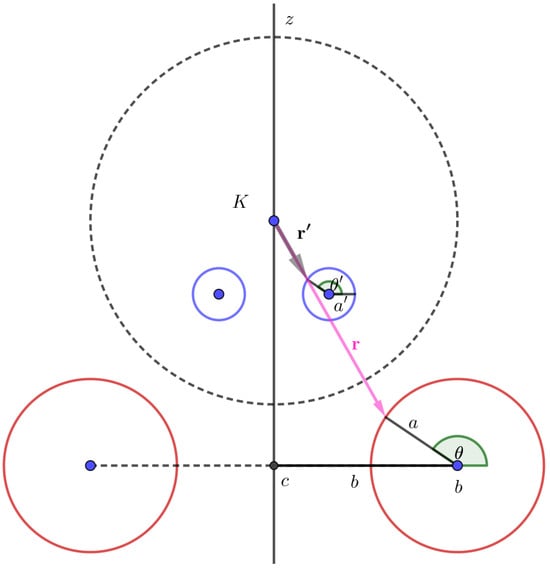
Figure 6.
Conducting torus in 2D.
Assuming that the torus inside is a surface of a freely charged conductor with potential Kelvin’s inversion enables its replacement by the outside surface of a torus at zero potential, influenced by a point charge equal to at the origin. If is the charge density inside the inverted torus, then
where r is the Euclidian distance and are the angles between a parallel to axis the and the radius of the torus, corresponding to the point and its inverse with respect to the inversion, respectively (Figure 6).
Using (34), Cade obtained the charge density, the capacity, and the total charge, taking into account previous known results, obtained using the perturbation method to the second order of for these quantities.
3.2.2. Dielectric-Coated Conducting Sphere
Pyati [13] studied the problem of a conducting sphere of radius with a concentric dielectric coating sphere of radius where under the influence of a primary electrostatic field which is due to a unit point charge placed at along the z axis (Figure 7).
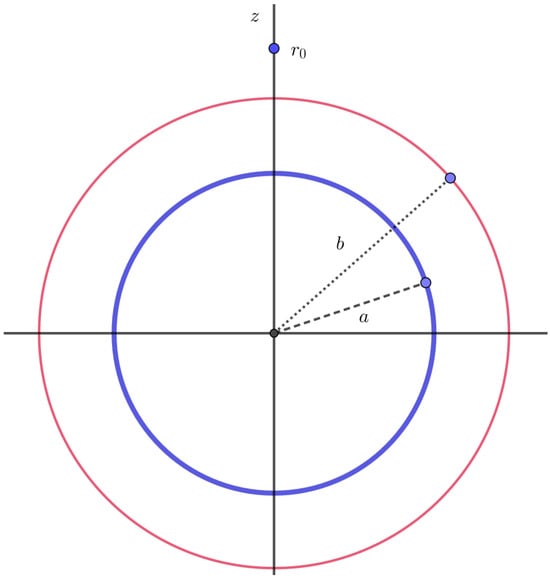
Figure 7.
Dielectric-coated conducted sphere in 2D.
The appropriate coordinate system [26] is the spherical one but the problem has azimuthal symmetry and the surfaces depend only on Therefore, only the radial coordinate is embedded in the solution. If and are the potentials to be determined where and respectively, then we have
where and are the perturbations caused by the dielectric-coated sphere. The imposed boundary conditions are
where K is the dielectric constant of the coating.
Expressing in spherical harmonics, the task was to obtain and In order to achieve this, they used the principle that, in this coordinate system, if is a harmonic function, then functions
are also harmonic, where is the radius of the sphere of Kelvin’s transformation and is an arbitrary function.
Taking into advantage (40) and assuming specific forms of and , which satisfied Laplace’s equation and the first two BCs, the remaining task was to determine the unknowns from the third BC.
This approach delivers results which converge faster than the well-known straightforward obtained solution.
3.2.3. Multipoles
Amaral et al. [14] studied the inverse multipoles in electrostatistics using Kelvin’s inversion. They used the inversed Poisson equation via the relation
where the primes denote the inverse quantities from Kelvin’s inversion. Taking into account the multipole expansion for the potential as a series using spherical harmonics and the integral for the spherical multipole moments, they derived the corresponding potential, the spherical multipole moments, and the electric field in the inverted regime and, therefore, the solution to the problem at hand. First, they applied the derived formulas in a spherical shell and in eccentric spheres. The other two of their applications deserve special reference: the case where the spherical cells pass through the origin (Kelvin’s inversion maps these spheres to planes) and the case of a torus without opening (Kelvin’s inversion maps these toruses to infinite cylinders).
3.3. Thermoelasticity
Chao and Wu [16] studied the problem of circular elastic inclusion bonded to a material matrix, which was subjected to arbitrary thermal loading.
They used the complex variable method to express the potential, and therefore the temperature T, and the heat flux using the relations
where k is the heat conductivity and is the potential to be derived.
Kelvin’s inversion can be used with complex variables, since a complex number is mapped to a vector in the complex plane and vice versa. Therefore, if the region is mapped to the region translating the internal problem (circular inclusion) into an external one (material matrix). For instance, if are the real and the imaginary parts of a holomorphic function expressed in polar coordinates [26], i.e.,
then
where the primes denote the inverted quantities via Kelvin’s inversion.
They studied two cases depending on the singularities, when all are in the material matrix or all in the inclusion. Moreover, the heat flux was assumed uniform at infinity (in the material matrix) or inside the inclusion or in a half-plane.
3.4. Potential Theory
Baganis and Hadjinicolaou used Kelvin’s inversion to study a problem in potential theory in a 2D non-convex domain using Dirichlet [9] or Neumann [10] boundary conditions. The non-convex body (its boundary is denoted with ) has a trefoil shape (Figure 8) and the exterior of the body (denoted as ) is the domain in which the solution had to be derived. If is the unknown potential, the equation which has to be satisfied is
with the Dirichlet boundary condition
or the Neumann boundary condition
where is the outward normal unit derivative on
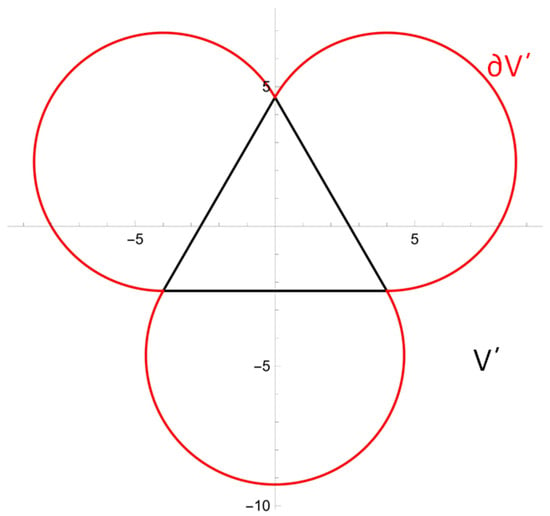
Figure 8.
A trefoil and its inverted equilateral triangle.
Using Kelvin’s inversion, the trefoil is transformed in an equilateral triangle and the domain into the interior of the triangle. Applying the Fokas method [12] and the results from [36], the solution of the inverted problem is obtained, and thus also the potential
3.5. Bioengineering
In order to study blood’s plasma flow past a red blood cell (RBC) in capillaries, Dassios et al. [17] used an inverted prolate spheroid as an RBC, and due to the physical requirements of the model, they assumed Stokes flow [31].
If is the fluid domain, is the RBC’s surface, U is the uniform velocity of plasma flow (Figure 9), is the Stokes operator in the inverse prolate coordinate system, is the position vector, and is the stream function, then the problem is defined via the relations
where is the radial cylindrical coordinate of the coordinate system and is the outward normal unit derivative on Expressing this problem in the inverse prolate spheroidal coordinates proved that it is very difficult to satisfy the far-field condition. The use of Kelvin’s inversion had a significant impact, since the corresponding interior problem in the prolate coordinate system is
where the equation expresses the surface of the prolate spheroid.
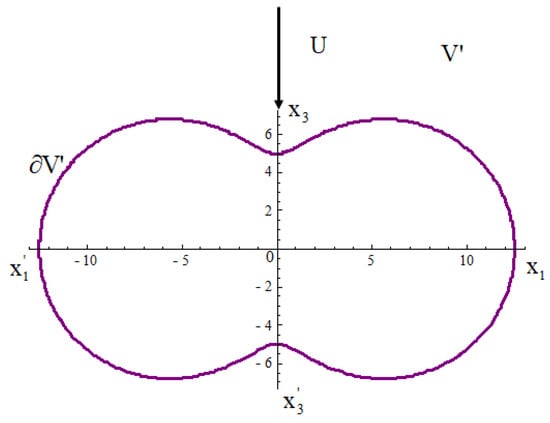
Figure 9.
Blood’s plasma flow past an RBC in 2D.
The solution of Stokes flow in the prolate spheroidal coordinate system is
where are Gegenbauer functions of the first and the second kind [35], respectively, and are linear combinations of the functions
Moreover, the inverted far-field condition from (47) can be written as the stream function in Equation (48), and upon applying orthogonality arguments with respect to the first set of the unknown constants were derived. In order to calculate the remaining unknown constants, the boundary conditions of (47) were employed, as well as the reduction of the obtained stream function to the previous known result of the stream function in the spherical coordinates. Therefore, the solution to the interior problem was derived:
where are constants, and using Kelvin’s transformation, the stream function in the exterior domain is
This work provided a useful way in order to solve the sedimentation of an RBC in blood’s plasma, the translation of two aggregated low-density lipoproteins within blood’s plasma, and blood’s plasma flow past a swarm of RBCs [37].
4. Discussion
Kelvin’s inversion is a transformation that maps a point to another one with respect to a sphere. Its usefulness is that it can transform the interior of a surface to the exterior of another surface and vice versa [38,39]. Hence, the solution of an exterior (or interior) problem can be obtained when the solution of the corresponding inverted one is known or can be easily derived, providing a powerful tool when targeting difficult problems. Whenever the geometry of the inverted surface is simpler to handle, the use of Kelvin’s inversion is an interesting option. Taking into account that it preserves harmonicity, its use in boundary value problems with partial differential equations provide solutions in cases where the straightforward methods do not. Kelvin’s inversion have been under continuous study, revealing significant properties. These properties have been used in science fields in order to solve various problems. In this paper, we summarized the basic properties of Kelvin’s transformation and presented some of its many applications in scattering, electrostaticity, thermoelasticity, potential theory, and bioengineering, highlighting its usefulness and usability when solving BVPs.
Funding
This research received no external funding.
Data Availability Statement
No new data were created or analyzed in this study. Data sharing is not applicable to this article.
Conflicts of Interest
The author declares no conflicts of interest.
Abbreviations
The following abbreviations are used in this manuscript:
| PDE | Partial Differential Equation |
| BVP | Boundary Value Problem |
| BC | Boundary Condition |
| RBC | Red Blood Cell |
References
- Axler, S.; Bourdon, P.; Ramey, W. Harmonic Function Theory; Springer: Berlin/Heidelberg, Germany, 1992. [Google Scholar]
- Thomson, W. Ex trait d’UN letterer DE M. William Thomson (reported by A. M. Liouville). J. Math. Pure Appl. 1845, 10, 364–367. [Google Scholar]
- Green, G. An Essay on the Application of Mathematical Analysis to the Theories of Electricity and Magnetism; Private Publication, Nottingham, UK, 1928. Also in Mathematical Papers of the Late George Green; Ferrers, N.M., Ed.; Macmillan: London, UK, 1871. [Google Scholar]
- Thomson, W. Papers on Electrostatics and Magnetism; MacMillan: London, UK, 1882. [Google Scholar]
- Thomson, W. Ex traits DE Dex letterers addressees A. M. Liouville. J. Math. Pure Appl. 1847, 10, 256–264. [Google Scholar]
- Dassios, G. The Kelvin transformation in potential theory and Stokes flow. IMA J. Appl. Math. 2009, 74, 427–438. [Google Scholar]
- Dassios, G.; Kleinman, R. On the Capacity and Reyleigh Scattering for a Class of Non–Convex Bodies. J. Mech. Appl. Math. 1989, 42, 467–475. [Google Scholar]
- Gintides, D.; Kyriakie, K. Low-Frequency acoustic scattering by a hard inverse-prolate spheroid. J. Mech. Appl. Math. 1992, 45, 231–244. [Google Scholar]
- Baganis, G.; Hadjinicolaou, M. Analytic Solution of an Exterior Dirichlet Problem in a Non-Convex Domain. IMA J. Appl. Math. 2009, 74, 668–684. [Google Scholar]
- Baganis, G.; Hadjinicolaou, M. Analytic Solution of an Exterior Neumann Problem in a Non-Convex Domain. Math. Methods Appl. Sci. 2010, 33, 2067–2075. [Google Scholar]
- Fokas, A.S. Two-dimensional linear partial differential equations in a convex polygon. Proc. R. Soc. A 2001, 457, 371–393. [Google Scholar]
- Fokas, A.S.; Kapaev, A.A. Riemann–Hilbert approach to the Laplace equation. J. Math. Anal. Appl. 2000, 251, 770–804. [Google Scholar]
- Pyati, P.V. Kelvin transformation for a dielectric-coated conducting sphere. Radio Sci. 1993, 28, 1105–1110. [Google Scholar]
- Amaral, G.P.L.R.; Ventura, S.O.; Lemos, A.N. Kelvin transformation and inverse multipoles in electrostatistics. Eur. J. Phys. IOP Publ. 2017, 38, 025206. [Google Scholar] [CrossRef]
- Cade, R. The Kelvin transformation of a torus. J. Appl. Phys. 1978, 49, 5722–5727. [Google Scholar]
- Chao, K.C.; Wu, H.C.; Ting, K. The inversion and Kelvin’s transformation in plane thermoelasticity with circular or straight boundaries. J. Mech. 2018, 34, 617–627. [Google Scholar]
- Dassios, G.; Hadjinicolaou, M.; Protopapas, E. Blood Plasma Flow Past a Red Blood Cell: Mathematical Modelling and Analytical Treatment. Math. Methods Appl. Sci. 2012, 35, 1547–1563. [Google Scholar]
- Hadjinicolaou, M.; Protopapas, E. Eigenfunction expansions for the Stokes flow operators in the inverted oblate coordinate system. Math. Probl. Eng. 2016, 2016, 9049131. [Google Scholar] [CrossRef]
- Simunkova, M. On Kelvin type transformation for Weinstein operator. Comment. Math. Univ. Carolin. 2001, 42, 99–109. [Google Scholar]
- Monti, R.; Morbidelli, D. Kelvin transform for Grushin operators and critical semilinear equation. Duke Math. J. 2006, 131, 167–202. [Google Scholar]
- Clerc, L.-J. Kelvin transformation and multi-harmonic polynomials. Acta Math. 2000, 185, 81–99. [Google Scholar]
- Michalik, K.; Ryznar, M. Kelvin transform for a-harmonic functions in regular domain. Demonstr. Math. 2012, 45, 361–376. [Google Scholar]
- Wei, Y.; Zhou, X. Pohozaev identities and Kelvin transformation of semilinear Grushin equation. arXiv 2024, arXiv:2404.11991v1. [Google Scholar]
- Koranyi, A. Kelvin transforms and harmonic polynomials on the Heisenberg group. J. Funct. Anal. 1982, 49, 177–185. [Google Scholar]
- Nabizadeh, S.M.; Ramamoorthi, R.; Chern, A. Kelvin transformations for simulations on infinite domains. ACM Trans. Graph. 2021, 40, 97. [Google Scholar]
- Moon, P.; Spencer, D.E. Field Theory Handbook; Springer: Berlin/Heidelberg, Germany, 1961. [Google Scholar]
- Hadjinicolaou, M.; Protopapas, E. Necessary and sufficient conditions for the separability and the R-separability of the irrotational Stokes equation. J. Appl. Math. Phys. 2020, 8, 2379–2401. [Google Scholar] [CrossRef]
- Liouville, J. Extension au cas des trois dimensions de la question du trace geographique. In Note VI. Application de l’Analyse a la Geometrie; Monge, G., Ed.; Bachelier, Imprimeur-Libraire: Paris, France, 1850; pp. 609–616. [Google Scholar]
- Stokes, G.G. On the theories of the internal friction of fluids on the motion of pendulums. Trans. Camb. Philos. Soc. 1849, 9, 287–319. [Google Scholar]
- Stokes, G.G. On the Effect of the Internal Friction of Fluids on the Motion of Pendulums. Trans. Camb. Philos. Soc. 1851, 8, 8–106. [Google Scholar]
- Happel, J.; Brenner, H. Low Reynolds Number Hydrodynamics; Kluwer Academic Publishers: Dordrecht, The Netherlands, 1991. [Google Scholar]
- Jeans, J. The Mathematical Theory of Electricity and Magnetism; Cambridge University Press: New York, NY, USA, 1960; Chapter VIII. [Google Scholar]
- Smythe, W.R. Static and Dynamic Electricity; Hemisphere: New York, NY, USA, 1989; Chapter V. [Google Scholar]
- Weiss, P. Applications of Kelvin’s transformation in electricity, magnetism and hydrodymanics. Proc. Camb. Philos. Soc. 1944, 40, 200–214. [Google Scholar]
- Wang, X.Z.; Guo, R.D. Special Functions; World Scientific: Singapore, 1989. [Google Scholar]
- Dassios, G.; Fokas, A.S. The basic elliptic equations in an equilateral triangle. Proc. Soc. A 2005, 461, 2721–2748. [Google Scholar]
- Hadjinicolaou, M.; Protopapas, E. Non-Convex Particle-in-Cell Model for the Mathematical Study of the Microscopic Blood Flow. Mathematics 2023, 11, 2156. [Google Scholar] [CrossRef]
- Ebenfelt, P.; Khavinson, D. On point to point reflection of harmonic functions across real-analytic hypersurfaces in Rn. J. Anal. Math. 1996, 68, 145–182. [Google Scholar] [CrossRef]
- Khavinson, D.; Lundberg, E. Linear Holomorphic Partial Differential Equations and Classical Potential Theory; American Mathematical Society: Providence, RI, USA, 2018. [Google Scholar]
Disclaimer/Publisher’s Note: The statements, opinions and data contained in all publications are solely those of the individual author(s) and contributor(s) and not of MDPI and/or the editor(s). MDPI and/or the editor(s) disclaim responsibility for any injury to people or property resulting from any ideas, methods, instructions or products referred to in the content. |
© 2025 by the author. Licensee MDPI, Basel, Switzerland. This article is an open access article distributed under the terms and conditions of the Creative Commons Attribution (CC BY) license (https://creativecommons.org/licenses/by/4.0/).